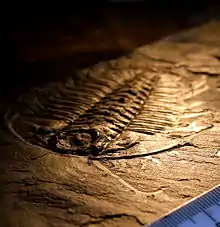Qingjiang biota
The Qingjiang biota are a major discovery of fossilized remains dating from the early Cambrian period approximately 518 million years ago.[1] The remains consist at least 20,000 individual specimens, and were discovered near the Danshui River in the Hubei province of China in 2019.[2] The site is particularly notable due to both the large proportion of new taxa represented (approximately 53% of the specimens),[1] and due to the large amount of soft-body tissue of the ancient specimens that was preserved, likely due to the organisms being rapidly covered in sediment prior to fossilization, that allowed for the detailed preservation of even fragile, soft-bodied creatures such as worms and jellyfish.
The site is a Burgess Shale type preservation,[1] and has been widely compared[1][3][4] to the Burgess Shale in terms of the site's richness and significance. The discovery has been described as one of the most significant of its kind in the last 100 years.[2] Initial publications regarding the site stated that 4,351 of the collected specimens had been examined,[2] and 101 species had been identified, 53 of which were new to science.[5]
Talks are reportedly underway with local government to protect the site to ensure the longevity of continued research on the deposited specimens.[4]
References
- Fu, Dongjing; Tong, Guanghui; Dai, Tao; Liu, Wei; Yang, Yuning; Zhang, Yuan; Cui, Linhao; Li, Luoyang; Yun, Hao; Wu, Yu; Sun, Ao; Liu, Cong; Pei, Wenrui; Gaines, Robert; Zhang, Xingliang (22 March 2019). "The Qingjiang biota—A Burgess Shale–type fossil Lagerstätte from the early Cambrian of South China". Science. 363 (6433): 1338–1342. doi:10.1126/science.aau8800. PMID 30898931.
- Cheung, Helier (24 March 2019). "Huge fossil discovery made in China's Hubei province". BBC News. British Broadcasting Corporation. Retrieved 9 April 2019.
- Lewis, Dyani. "Chinese fossil site rivals Burgess Shale". Cosmos. Retrieved 9 April 2019.
- Greshko, Michael. "Spectacular new fossil bonanza captures explosion of early life". National Geographic. National Geographic. Retrieved 9 April 2019.
- "Paleontologists Discover 518 Million-Year-Old Fossil Site in China". Sci-News. 26 March 2019. Retrieved 9 April 2019.
